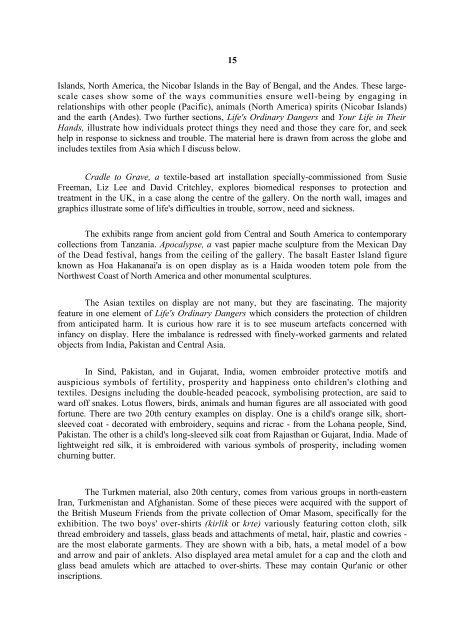download - OATG. Oxford Asian Textile Group
download - OATG. Oxford Asian Textile Group
download - OATG. Oxford Asian Textile Group
- No tags were found...
You also want an ePaper? Increase the reach of your titles
YUMPU automatically turns print PDFs into web optimized ePapers that Google loves.
15Islands, North America, the Nicobar Islands in the Bay of Bengal, and the Andes. These largescalecases show some of the ways communities ensure well-being by engaging inrelationships with other people (Pacific), animals (North America) spirits (Nicobar Islands)and the earth (Andes). Two further sections, Life's Ordinary Dangers and Your Life in TheirHands, illustrate how individuals protect things they need and those they care for, and seekhelp in response to sickness and trouble. The material here is drawn from across the globe andincludes textiles from Asia which I discuss below.Cradle to Grave, a textile-based art installation specially-commissioned from SusieFreeman, Liz Lee and David Critchley, explores biomedical responses to protection andtreatment in the UK, in a case along the centre of the gallery. On the north wall, images andgraphics illustrate some of life's difficulties in trouble, sorrow, need and sickness.The exhibits range from ancient gold from Central and South America to contemporarycollections from Tanzania. Apocalypse, a vast papier mache sculpture from the Mexican Dayof the Dead festival, hangs from the ceiling of the gallery. The basalt Easter Island figureknown as Hoa Hakananai'a is on open display as is a Haida wooden totem pole from theNorthwest Coast of North America and other monumental sculptures.The <strong>Asian</strong> textiles on display are not many, but they are fascinating. The majorityfeature in one element of Life's Ordinary Dangers which considers the protection of childrenfrom anticipated harm. It is curious how rare it is to see museum artefacts concerned withinfancy on display. Here the imbalance is redressed with finely-worked garments and relatedobjects from India, Pakistan and Central Asia.In Sind, Pakistan, and in Gujarat, India, women embroider protective motifs andauspicious symbols of fertility, prosperity and happiness onto children's clothing andtextiles. Designs including the double-headed peacock, symbolising protection, are said toward off snakes. Lotus flowers, birds, animals and human figures are all associated with goodfortune. There are two 20th century examples on display. One is a child's orange silk, shortsleevedcoat - decorated with embroidery, sequins and ricrac - from the Lohana people, Sind,Pakistan. The other is a child's long-sleeved silk coat from Rajasthan or Gujarat, India. Made oflightweight red silk, it is embroidered with various symbols of prosperity, including womenchurning butter.The Turkmen material, also 20th century, comes from various groups in north-easternIran, Turkmenistan and Afghanistan. Some of these pieces were acquired with the support ofthe British Museum Friends from the private collection of Omar Masom, specifically for theexhibition. The two boys' over-shirts (kirlik or krte) variously featuring cotton cloth, silkthread embroidery and tassels, glass beads and attachments of metal, hair, plastic and cowries -are the most elaborate garments. They are shown with a bib, hats, a metal model of a bowand arrow and pair of anklets. Also displayed area metal amulet for a cap and the cloth andglass bead amulets which are attached to over-shirts. These may contain Qur'anic or otherinscriptions.
















